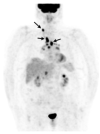Sarcoidosis: A Clinical Overview from Symptoms to Diagnosis
- PMID: 33807303
- PMCID: PMC8066110
- DOI: 10.3390/cells10040766
Sarcoidosis: A Clinical Overview from Symptoms to Diagnosis
Abstract
Sarcoidosis is a multi-system disease of unknown etiology characterized by the formation of granulomas in various organs. It affects people of all ethnic backgrounds and occurs at any time of life but is more frequent in African Americans and Scandinavians and in adults between 30 and 50 years of age. Sarcoidosis can affect any organ with a frequency varying according to ethnicity, sex and age. Intrathoracic involvement occurs in 90% of patients with symmetrical bilateral hilar adenopathy and/or diffuse lung micronodules, mainly along the lymphatic structures which are the most affected system. Among extrapulmonary manifestations, skin lesions, uveitis, liver or splenic involvement, peripheral and abdominal lymphadenopathy and peripheral arthritis are the most frequent with a prevalence of 25-50%. Finally, cardiac and neurological manifestations which can be the initial manifestation of sarcoidosis, as can be bilateral parotitis, nasosinusal or laryngeal signs, hypercalcemia and renal dysfunction, affect less than 10% of patients. The diagnosis is not standardized but is based on three major criteria: a compatible clinical and/or radiological presentation, the histological evidence of non-necrotizing granulomatous inflammation in one or more tissues and the exclusion of alternative causes of granulomatous disease. Certain clinical features are considered to be highly specific of the disease (e.g., Löfgren's syndrome, lupus pernio, Heerfordt's syndrome) and do not require histological confirmation. New diagnostic guidelines were recently published. Specific clinical criteria have been developed for the diagnosis of cardiac, neurological and ocular sarcoidosis. This article focuses on the clinical presentation and the common differentials that need to be considered when appropriate.
Keywords: cardiac sarcoidosis; diagnostics; differentials; granulomatosis; neurosarcoidosis; sarcoidosis.
Conflict of interest statement
The authors declare no conflict of interest related to this article.
Figures










References
-
- Besnier E.H. Lupus Pernio de La Face; Synovites Fongueuses (Scrofulo-Tuberculeuses) Symétriques Des Extrémités Supérieures. Ann. Derm. Syph. 1889;10:333–336.
-
- Hunninghake G., Costabel U. Statement on Sarcoidosis. Am. J. Respir. Crit. Care Med. 1999;160:20. doi: 10.1034/j.1399-3003.1999.14d02.x. - DOI
Publication types
MeSH terms
LinkOut - more resources
Full Text Sources
Other Literature Sources
Medical

